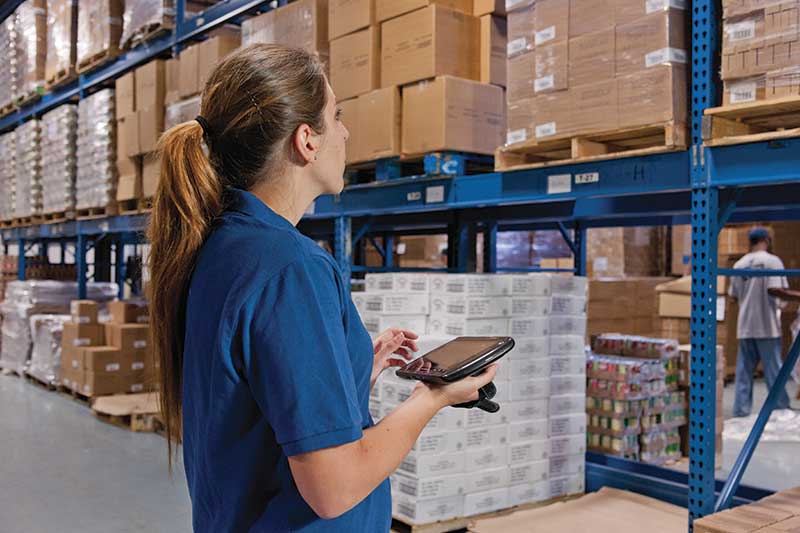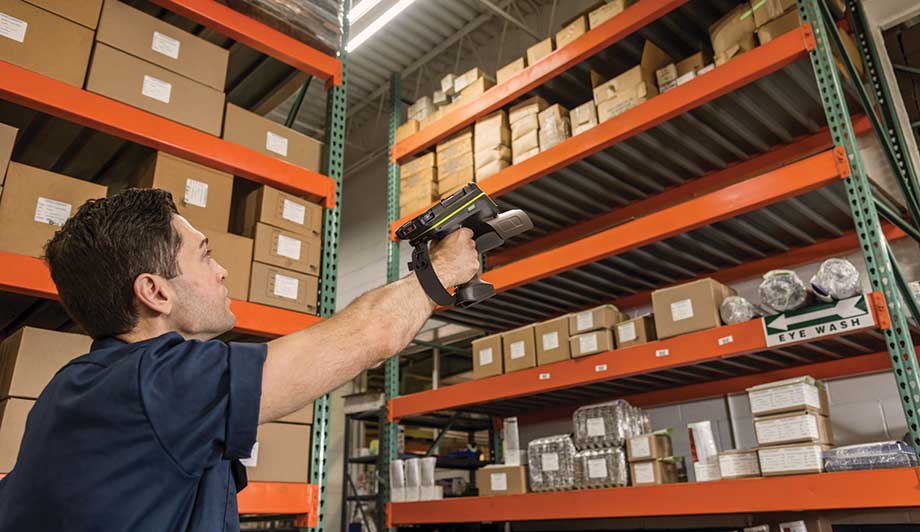Wireless Mobility: Ready for the next leg up
Widely used inside the four walls, wireless mobile devices from scanners and printers to tablets are a strong player in facility productivity. Recent advances ensure that they’ll become increasingly valuable to workflows and throughput efficiencies.

Many of the stories that appear in Modern Materials Handling are about trends in early stages. This is not one of those stories.
Wireless mobility is already well established within the four walls. In fact, “90% plus of facilities today use wireless devices to some degree,” says Mark Wheeler, director of supply chain solutions at Zebra Technologies.
Better yet, wireless mobility is an essential. “Enterprise mobility is a business-critical asset, with 98% of all IT respondents [to a survey] highlighting their dependence on reliable enterprise mobile devices and apps for worker productivity, workflows, decision making and more.” That’s according to that recent survey by B2M Solutions and Peak Technologies.
And in a world where 52% is considered a firm majority, those IT professionals say reliable mobile devices and apps overwhelmingly enable top level operational performance: 98% say wireless mobility enables frontline worker productivity and enhances workflow as well as speeds decision making and improves customer service/customer experience. And 96% directly link wireless mobility to revenue growth.
Or to put it another way, “nothing gives you the same ROI as mobile wireless devices. They provide a lot of value,” says Robert Brice, president of RFGen.
All of which is great, but not enough.
As Wheeler says, wireless mobility may be in a facility, but not everywhere. Brice puts wireless mobility use at just one to three warehouse workflows. All other workflows remain manual. That’s according to a survey, “Digital Inventory Report,” done by RFGen in late 2022.
And in some cases, legacy systems open the door to upgrades with the latest technology. And that extends from the devices themselves—tablets, scanners, printers and more—to infrastructure including advanced Wi-Fi and upgraded security systems.
“Technology plays a critical and ever-growing role supporting warehouse improvement initiatives,” says the VDC Research report “Warehouse operations 2022: Streamlining technology investment time to value and overcoming new technology investment challenges.”
In the report, David Krebs, executive vice president at VDC, singles out labor scarcity and retention issues. Furthermore, organizations are “looking to complement labor operations with increasing investments in warehouse automation.

In 2021 (the most recent year with numbers), investments in technologies from mobile and wearable computing and data capture to machine vision and robotics grew at unprecedented rates, often more than 25% to 30% year over year,” he says.
This is the story of what can be done to make even high performing wireless mobile devices even more valuable within the four walls.
Continuous digital chain of custody
The growth of wireless mobility is simply “change driven by problems,” says Brice.
“People are constantly looking for other places in their operations to improve,” Brice adds. “They want to reduce errors as well as identify who and where inventory was handled at each stage of the operation. Perhaps most importantly, companies want to establish a continuous digital chain of custody for every item in their facility. At this point, there’s simply no reason not to have that.”
In fact, he says 58% of his survey respondents expect to spend more on tech-related projects in the near term. But 16% say their company’s mobile systems are sufficient for their current needs.
Fortunately, wireless mobile devices have a lot going for them even before recent product introductions.
Let’s start with the form factor.
“With wearable computers, there’s no need for mobile workers to find, pick up and set down a handheld scanner. Instead, they’re wearing it on their arm,” explains Scott Stelter, director of offering management for Honeywell Productivity Solutions and Services. That instant availability “empowers warehouse workers to stay productive, connected and efficient within every touchpoint of their workflows,” adds Stelter.
Along these lines, Honeywell recently introduced its CW45 wearable computer. Described as comfortable, powerful, compact and durable, the device ergonomically presents workflow information to the worker without slowing down operations with a 4.7 inch high-definition display. In addition, it uses advanced Wi-Fi 6 to connect to the in-house network to keep all data in real time relevance. More on advances in Wi-Fi here in a bit.
Since one solution certainly does not solve all problems, Honeywell has also introduced its 8675i hand-wearable scanner. This compact unit reads damaged as well as perfect bar codes in workflows that previously could only be serviced by bulkier, heavier handheld devices, explains Stelter.
Along those same lines, Zebra has brought along its WS 50 Android-based wearable computer, says Wheeler. Billed as “the world’s smallest all-in-one Android enterprise-class wearable mobile computer,” the device includes an integrated imager capable of scanning most any bar code even when the scanner and bar code are in motion. In addition, the unit can be tied directly to a voice-based data collection and management system.
Zebra has also come along with its WT6000 wearable computer that’s said to be easy to wear without interfering with hands-free mobility. The touchscreen displays intuitive graphical Android applications. It also offers tap-to-pair capabilities to Zebra’s Bluetooth ring scanner, Bluetooth headset and Bluetooth printers.

Meanwhile, Zebra offers the TC5X series of rugged mobile computers. Wheeler explains that these touch computers can be worn on the back of the wrist and include a built-in scanner. Network communication is over Wi-Fi 6.
These and other wireless mobile devices are all different than what has come before them. Legacy systems that don’t include touchscreens or screen colors or various type fonts are rapidly becoming the past.
And with good reason. Those legacy systems are so different from current technology outside of the facility that you get training and adoption issues, explains Brice. Makes what’s being introduced now almost inevitable.
The Cloud, Wi-Fi and security
Much the same can be said for what’s happening with mobile wireless systems when it comes to the Cloud, security and Wi-Fi.
According to the RFGen survey, 31% of companies are currently operating in the Cloud with another 20% planning to move to it. The balance, 49%, do not yet have solid plans to move to the Cloud, says Brice. Regardless of the trajectory of the move to the Cloud in the plant and warehouse, it’s reasonable to assume it will be a critical part of wireless mobility infrastructure going forward.
On the other hand, Wi-Fi, while relatively ubiquitous inside the four walls, continues to evolve and the devices are keeping pace, says Wheeler. According to a Zebra report, “the pace of evolution is increasing; Wi-Fi 6 and Wi-Fi 6E have arrived.” And they’re in place at advanced facilities.
Wheeler explains that Wi-Fi 6 quadruples bandwidth and capacity, reducing congestion and interference. Furthermore, latency is reduced by 75% (according to Intel). This means a substantial increase in devices and traffic won’t impact application performance, adds Wheeler.
One note about cellular communications such as 4G and 5G. Cellular continues to be rarely used within the four walls, but not outside them. No one expects to see that shift, keeping Wi-Fi in the premiere network communications position indoors. However, there are instances when cellular and Wi-Fi are being integrated as the communications network encompasses the yard as well as inside the four walls.
As part of this is a new wireless option known as private LTE networks. The most popular option is Citizens Band Radio Service (CBRS). Right now, CBRS is most often associated with pop-up warehouses or micro-fulfillment centers, says Stelter of Honeywell. However, the vast majority of operations are better off at this point knowing what CBRS stands for rather than pursuing it actively as a network option.
There’s also the matter of security. While outside hacks are a concern to all from IT to operations, security sophistication for mobile devices has advanced to a stage that is highly manageable, says Wheeler. The latest protocol, WPA 3, is a significant upgrade from WPA 2, ensuring security not just on the Wi-Fi network but on the Cloud.

Managing all that data
Clearly, mobile devices are not islands of automation. All the data collected needs to go somewhere, and still additional data needs to return to mobile devices to guide next steps in workflows.
While some data is shared with other devices such as printers, the vast majority is typically fed to warehouse management systems (WMS), increasingly to Cloud-based systems. Stelter says devices integrated with a Cloud-based WMS offer a superior option for supporting an entire range of warehouse operational tasks.
There’s also the matter of managing workers dynamically using the devices to maximize their flexibility and responsiveness, explains Stelter. He calls them workforce intelligence solutions that provide advanced analytics to maximize productivity as well as workflow and process compliance.
Stelter adds that Honeywell’s Operational Intelligence helps manage workflows in real time with disruptions that require new accommodations to maintain the desired workflow.
Clearly, wireless devices have gone far beyond initial entries that made possible scanning and printing on the go. Stelter sums up what’s going on in wireless mobility this way.
“Operations can leverage the data found in DCs and warehouses to create efficiency, increase productivity and minimize errors,” adds Stelter. “Data utilization is among the most critical issues facing modern DCs. With slim profit margins and soaring consumer expectations, operations managers can’t afford to ignore operational data and still expect better outcomes.”

Article Topics
Honeywell News & Resources
Honeywell to drive DC efficiency and enhanced storage capacity via collaboration with Hai Robotics Light-directed systems meet integrated solutions Honeywell demonstrates depalletizer and AS/RS Wireless Mobility: Ready for the next leg up Rapid WMS rollout fits functional needs Real benefits with simulation Automated palletizing pays for itself More HoneywellLatest in Materials Handling
Materials Handling Robotics: The new world of heterogeneous robotic integration Lucas Watson appointed CSO for Körber’s Parcel Logistics business in North America Hyster recognizes Dealers of Distinction for 2023 Carolina Handling names Joe Perkins as COO C-suite Interview with Keith Moore, CEO, AutoScheduler.AI: MODEX was a meeting place for innovation Walmart deploying autonomous lift trucks at four of its high-tech DCs Coles shops big for automation More Materials HandlingAbout the Author
Subscribe to Materials Handling Magazine

Find out what the world's most innovative companies are doing to improve productivity in their plants and distribution centers.
Start your FREE subscription today.
April 2024 Modern Materials Handling

Latest Resources











